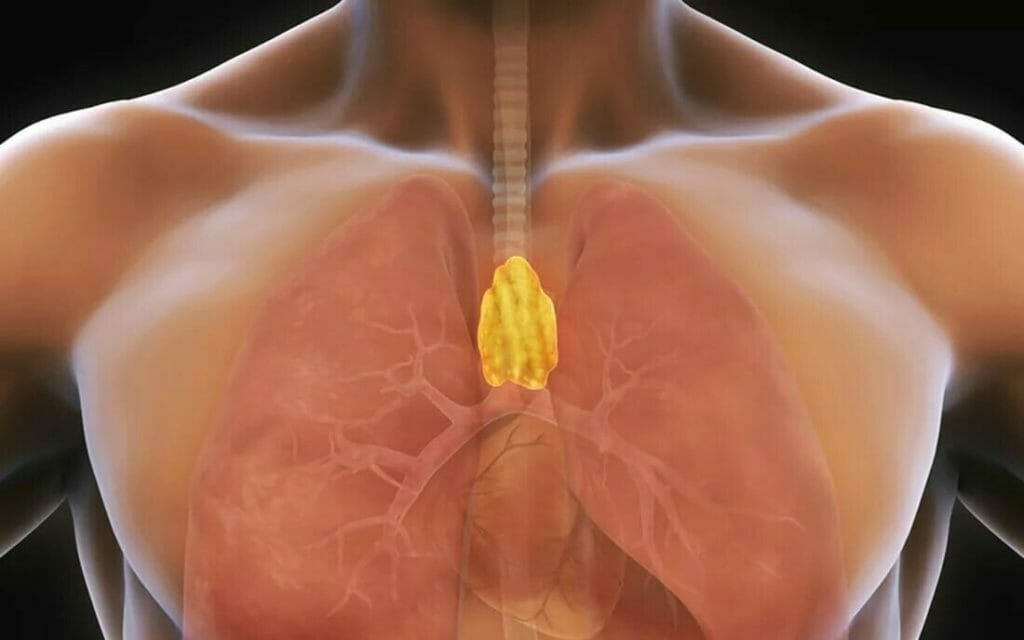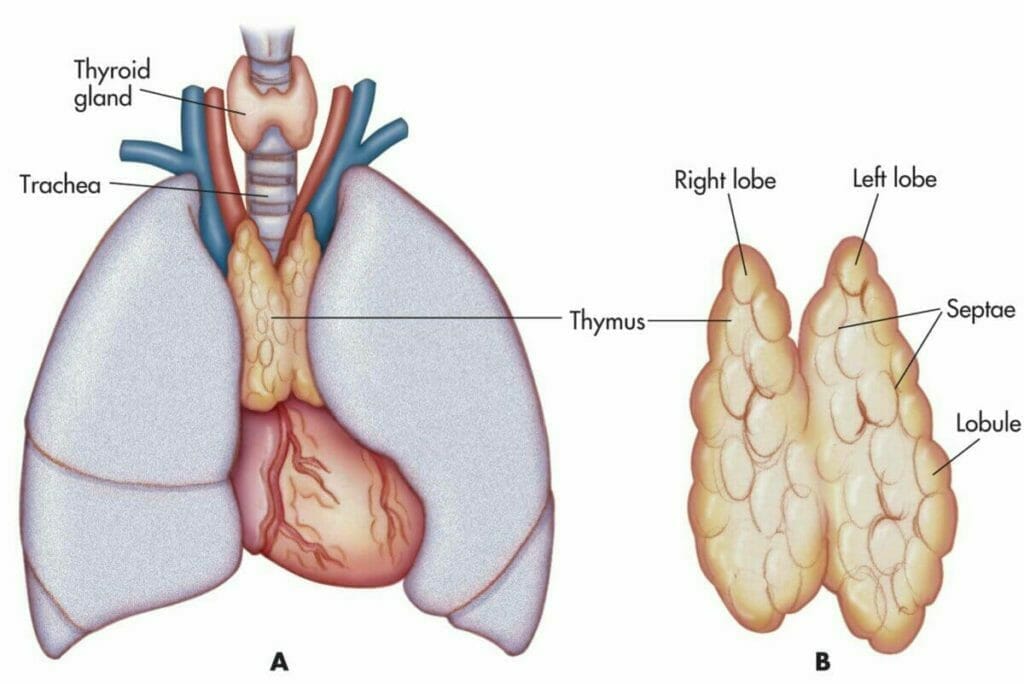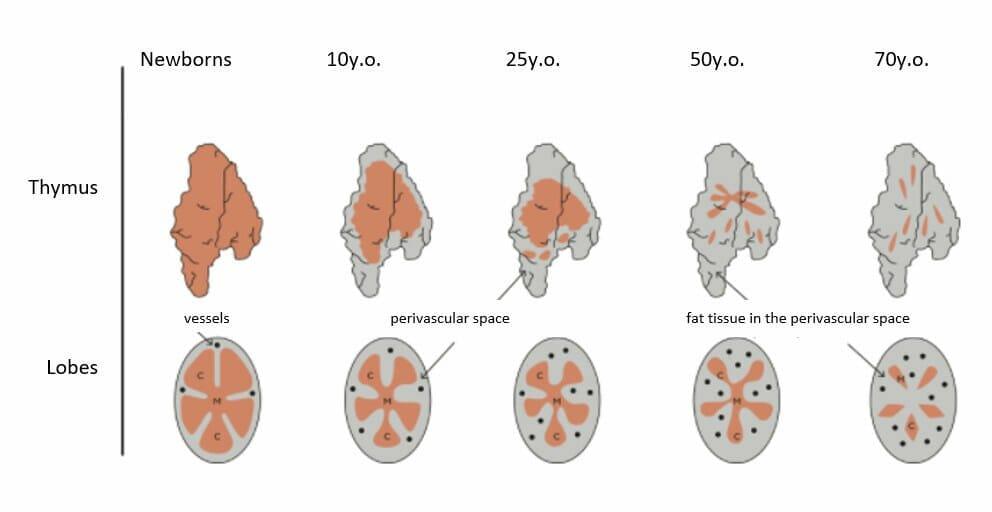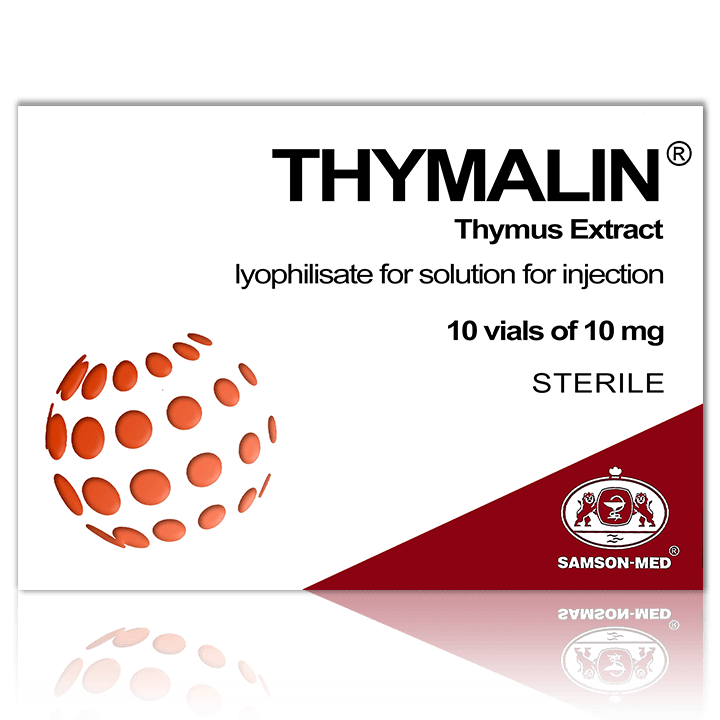Thymus peptides in Immunology and age-Prevention
November 2, 2021
Briefly about peptides
Peptides are short fragments of proteins of natural or artificial origin consisting of 2-3 or more amino acid residues linked together by a peptide bond. Some call them “younger brothers” of proteins, because generally speaking these two classes of molecules differ only in size: if a molecule consists of more than 50 amino acid residues, it is a protein, and if less – it’s a peptide. So, by the size of the molecules and their properties, peptides stand between high molecular weight proteins and amino acids.

Peptides are responsible for protein synthesis, and if one adds them to the body, they help restore normal protein synthesis, which means they slow down aging and start the body’s recovery processes.
The important thing about peptide drugs is that they have low toxicity and a wide range of possible molecular targets. All peptides can be divided into two categories: natural peptides and synthetic peptides. Let’s take a closer look at each group.
Natural Peptides
Natural peptides are usually of animal origin. Some of the most famous ones include CEREBROLYSIN – a neurometabolic stimulator based on neuropeptides and amino acids isolated from pig brain tissue. This preparation has proven to be effective when used in: strokes and stroke complications, Alzheimer’s disease and other types of dementia, traumatic brain injuries, spinal cord injuries, ADHD in children, antidepressant-resistant depressions, and other cerebral diseases. CORTEXIN is a mixture of neuropeptide fractions, amino acids, vitamins, and minerals, all of which have a pronounced but subtle positive effect on the brain. Similar to Cerebrolysin, Cortexin is based on neuropeptides and amino acids. However Cortexin has significantly more peptide fractions and fewer amino acids. You can read more about both preparations in this article.
Another popular natural peptide is THYMOGEN – an immunomodulator containing chemically synthesized dipeptide Glu-Trp (glutamyl-tryptophan) equal to a natural compound of thymus extract. Thymogen is a versatile preparation that has the following dosage forms: ampoules, spray, and cream. Its spray form is usually used as a prophylactic and treatment of acute and chronic non-specific lung diseases. The injection form is used for the treatment of various acute and chronic viral and bacterial infections that are accompanied by weakened immunity. The cream form is used for the treatment of dermatitis and as a regeneration aid for the treatment of wounds and scars.
Synthetic Peptides
The development of synthetic peptides is also of high interest because it was found that replacing only one amino acid in the structure of a peptide is capable of increasing its biological activity up to several times. Moreover, synthetic peptides are often used in vaccine development.
Most popular preparations based on synthetic peptides include Semax and Selank nasal drops. By its structure, Semax is a fragment of endogenous neuropeptide ACTH. Primary uses of Semax 0.1% are: increasing attention during repetitive and monotonous tasks; increasing intellectual capacity in extreme circumstances; alleviating the effects of cerebrovascular diseases. Semax 1% is usually used for faster recovery after strokes; alleviation of migraines; transient ischemic attacks. Selank is a triple-action peptide that is said to protect against stress, restore nerve cells, and improve brain function.
Another well-known Russian peptide nootropic drug is NOOPEPT. Its effect is based on the formation of active compound cyclopropyl glycine, which is naturally occurring in the brain. Noopept increases alpha/beta1 activity in all brain areas. The preparation can be officially used for both healthy individuals who want to optimize their mental performance and for the treatment of impaired memory formation, ADHD, emotionally labile disorders, various brain injuries, or asthenic disorders. The preparation also has antioxidant properties. You can read more about Noopept here.
Thymus Peptides

In recent decades, attention of researchers and clinicians has been largely attracted by the new class of medical preparations – peptide bioregulators obtained by extraction from animal organs and tissues. An experiment on animals proved their geroprotective effect on the body: an increase in average and maximum life expectancy, inhibition of carcinogenesis, a decrease in the frequency of malignant neoplasms, and a normalizing effect on metabolism and immunity [5]
Thymus – what is it?
The thymus gland (Greek thumos, meaning “anger”, or “heart, soul, desire, life”) is the central organ of cellular immunity. It has been known since the time of the ancient Greeks. But its importance in the immune system was discovered only in 1961 by Jacques Miller when he surgically removed the thymus from one day old mice, and observed the subsequent deficiency in a lymphocyte population, later named T-cells after the organ of their origin. [7][8]
Thymus is the place where the maturation of T-lymphocytes occurs. T-lymphocytes are the main functional elements that provide immune surveillance in the body.

Thymus is located in the upper front part of the chest behind the sternum, and in front of the heart, stretching upwards towards the neck. It is made up of two lobes, each consisting of a central medulla and an outer cortex, surrounded by a capsule. The lobes are divided into smaller lobules. At birth it is about 4–6 cm long, 2.5–5 cm wide, and about 1 cm thick. It increases in size until puberty, where it may have a size of about 40–50 g. In the subsequent years it decreases in size in a process known as involution.

It has been proven that its function is the production of peptides that have an effect on the differentiation of T-lymphocytes, and to a much lesser extent, B-lymphocytes. At the same time, the thymus gland is part of the endocrine system. Its functioning is closely related to the activity of the adrenal, reproductive and thyroid glands, pineal and pituitary glands. There is a functional antagonism between the glucocorticoid function of the adrenal cortex and the secretory activity of the thymus gland: an increase in glucocorticoid secretion suppresses the secretory activity of the thymus, an increase of the thymic hormone in the blood reduces the glucocorticoid function of the adrenal glands [6].
Abnormalities of the thymus can result in a decreased number of T-cells and autoimmune diseases.
According to professor Khavinson who wrote a book on Peptide Preparations of Thymus and Pineal Gland in Prevention of Accelerated Aging, peptide bioregulators from the thymus gland can rightfully be classified as a means of substitution therapy, since with increasing age there is a steady deterioration in the functional state of both glands. Therefore, it is not surprising that the transplantation of pineal glands and thymus from young animals to old ones leads to a pronounced anti-aging effect and an increase in life expectancy in many experiments. The same effect on elderly animals was exerted by the introduction of the epiphyseal hormone melatonin or epithalamin, an extract of the pineal gland (drug analogue – Pineamin). Both substances eliminated or reduced the number of age-related changes in neuroendocrine regulation, immunity, lipid and carbohydrate metabolism, and had a normalizing effect on the processes of lipid peroxidation and the activity of antioxidant enzymes. [6]
Thymus peptides are highly selective, effective in very small doses, easily excreted from the body, and usually do not cause side effects. Currently, a number of thymus preparations (thymosin, thymostimulin, thymoptin, T-activin, thymalin, etc.) and their synthetic analogs (thymosin alpha, thymogen etc.) are used in the experiment and clinic.
THYMALIN [Thymus Extract]

Thymalin (Timalin) is a polypeptide medicine with a molecular weight of less than 10kDa containing an extract of young horned cattle thymus. Thymalin is a natural physiological immunostimulant. The medication is said to stabilize the immune response and regulate the T- and B-cell ratio. Thymalin has a broad application scope. It can be used in case of immunosuppression of any origin and is compatible with antiviral medications.
Thymalin was isolated in 1974 by V. G. Morozov and V. Kh. Khavinson from the thymus gland of calves. The thymus tissue was treated with acetone, homogenized, extracted with 3% acetic acid in the presence of zinc chloride for 72h, and acetone was added to the supernatant. The precipitate was washed many times with acetone and dried. This complex of polypeptides was further subject to additional purification; sparingly soluble fractions were removed from it. [1] The isolated complex was named Thymalin and was approved by the USSR Pharmacological Committee for clinical use in 1977.
An experimental study revealed a wide spectrum of the pharmacological activity of Thymalin, manifested in the restoration of a number of physiological functions of the body: immunological activity, hematopoiesis, hemostasis, neuroendocrine regulation, etc.
Thymalin is indicated for:
- Immunodeficiency states in adults and children (6 months old +);
- Acute and chronic viral and bacterial infections;
- Infectious purulent and septic processes;
- Suppression of immunity and hematopoiesis after chemotherapy or radiation therapy in patients with cancer;
- Persistent violations of the thymus function (radiation sickness, tumors of the thymus, surgical removal of the thymus).
According to the results of the latest clinical study of Dr Khavinson et al in 2020 Thymalin is recommended for use in the complex therapy of coronavirus infection and in vaccination against COVID-19. [14] Results of the comparative assessment of IgG antibodies to SARS-CoV-2 in dynamics at standard and complex treatment with Thymalin of patients with COVID-19 were studied and it was found that after standard treatment, patients showed a decrease in antibody levels by 53% after 104 days. While the addition of Thymalin to standard therapy slowed down the decline of this indicator. This contributed to maintaining strained adaptive immunity. It is considered promising to continue the studies on Thymalin use in the treatment of patients with COVID-19.
Experimental data about the effects of Thymalin
Immunomodulatory effects. The introduction of Thymalin to guinea pigs has a modulating effect on both the lymphoid and reticuloepithelial components of the thymus gland. The structure of the thymus changes due to the proliferation and differentiation of lymphoid elements and an increase in the number of mature (small) lymphocytes in it. [11]
When intact rats were injected with Thymalin for 2 weeks, the indices of immunity and nonspecific resistance of the organism changed: the titer of complement decreased, the bactericidal activity of serum and the content of beta-lysines increased. In thymectomized guinea pigs and rats, Thymalin restored the number of T-lymphocytes in the peripheral blood, spleen, and lymph nodes. In thymectomized mice, the state of not only cellular, but also humoral immunity changed. The introduction of Thymalin led to the restoration of the immune response and an increase in the titer of hemagglutinins and hemolysins [11].
The use of Thymalin is most effective in thymus-dependent immunological deficiency. In experiments on animals, it was found that it stimulates the reactions of cellular immunity and the immune response to thymus-dependent antigens. Thymalin administration to thymectomized animals promoted restoration of the number and functional activity of T-lymphocytes and humoral immune response to sheep erythrocytes. [9]
Normalization of hemostasis indicators. Thymalin is not only a modulator of cellular and humoral immunity, but also the hemostatic system. In cases where patients have hypercoagulation and inhibition of fibrinolysis, Thymalin leads to the normalization of the studied parameters of the hemostatic system [12].
In in vitro experiments, Thymalin has a weak anticoagulant effect, slightly slows down blood clotting and inhibits fibrinolysis. At the same time, in in vivo observations, Thymalin modulates the responses of the hemostatic system. A single administration of Thymalin to cats does not have a significant effect on blood clotting and fibrinolysis. If Thymalin is administered to cats or rats daily for 7 days, then along with the activation of cellular and humoral immunity, an increase in blood clotting time, an increase in the concentration of natural anticoagulants and stimulation of fibrin clot lysis are recorded. [12]
It has been shown that in adult thymectomized animals (rats, rabbits, guinea pigs, mice, dogs), after 1.5-2 months, there is an increase in platelet aggregation activity, an acceleration of blood coagulation, a decrease in anticoagulant activity, an increase in the concentration of fibrinogen and V, VII, VIII and X factors, a decrease in the antiaggregatory activity of the vascular wall, as well as inhibition of fibrinolysis. In addition, the concentration of kallikrein increases and the activity of kininogen decreases, which can be explained by its transition to kinin. At the same time it was shown that daily administration of Thymalin to thymectomized animals for 7 days completely restores the impaired parameters of the hemostasis system and the kallikrein-kinin system [12].
Oncostatic action. Thymalin was used for various oncological diseases: breast cancer, uterine corpus cancer, lung, stomach cancer etc. The main goal of therapy for these indications is the restoration of cellular immunity after radiation therapy and chemotherapy.
Injections of Thymalin to irradiated mice and rats for 10 days on a monthly basis led to a 2-fold decrease in malignant neoplasms. In mice subjected to fractionated irradiation, the use of thymus peptides was accompanied by a 3.5-fold decrease in the number of tumors. The incidence of tumors in female rats injected with 7,12-Dimethylbenz[a]anthracene and Thymalin decreased by 24%, and the incidence of mammary adenocarcinomas – by 3.8 times. In such animals, life expectancy increased significantly. [11]
In SHR mice, which were injected with Thymalin starting from the 4th month of life, the frequency of spontaneous tumors decreased from 55 to 40%. In female mice of the C3H/Sn line under the influence of Thymalin (the drug was injected throughout life, starting from one month old), the frequency of spontaneous tumors decreased 2.8 times, and mammary adenocarcinomas – 2.6 times. [11]
According to the official product website, Thymalin helps to reduce symptoms of toxicity during radiation and chemotherapy. This allows patients to complete their planned course in the fight with cancer.
Correction of lipid metabolism disorders. Thymalin is capable of exerting a pronounced effect on the course of metabolic processes. The introduction of Thymalin to thymectomized guinea pigs is accompanied by the restoration of disturbed biochemical blood parameters. Thymalin injections in rabbits with atherosclerosis lead to a decrease in cholesterol levels in the blood, liver and aorta and less pronounced atherosclerotic vascular lesions. At the same time, the sensitization of lymphocytes to atherogenic lipoproteins decreased. [4]
Molecular cell mechanisms of Thymalin action. A large number of experiments is devoted to the study of the action of Thymalin at the cellular level. It was found that the drug increases the content of cAMP and adenylate cyclase in the precursor cells of T-lymphocytes and almost does not change the concentration of these enzymes in differentiated structures. When adding Thymalin to thymus cells, the concentration of cAMP also increases and the level of cGMP decreases. [2] An increase in the expression of receptors on T-lymphocytes under the influence of thymus peptides is associated with an increase in the intracellular content of cAMP, which serves as a trigger for biochemical processes that determine the differentiation of the least mature cells.
If T-lymphocytes of patients with impaired immunity are treated with Thymalin, the reactivity of the adenylate cyclase system is restored to normal, and there is also a clear tendency towards normalization on the part of the LDH isozyme spectrum, which indicates the activation of the processes of differentiation of T-lymphocytes. [6]
Thymalin Clinical Research
In clinical practice, Thymalin has been in use since 1977 to correct immunological disorders in various diseases. The drug was first used in patients with chronic pyo-inflammatory diseases accompanied by a significant suppression of the T-system of immunity and tissue regeneration processes. The introduction of Thymalin restored the number and functional state of T-lymphocytes, and promoted a decrease in the number of B-lymphocytes to normal, which led to an improvement in the clinical condition of patients, and activation of reparative processes. [6]
The use of Thymalin in patients with chronic nonspecific lung diseases contributed to the normalization of many indicators of cellular immunity and nonspecific body defense. The improvement in immunity parameters was combined with the improvement or disappearance of inflammation in the lungs. In elderly patients with chronic nonspecific lung disease accompanied by a decrease in the function of the thymus gland under the influence of Thymalin treatment, there was a restoration of the functional activity of T-lymphocytes, an improvement in the parameters of the hemostasis system, carbohydrate, lipid and nitrogen metabolism. [12]
The use of Thymalin in cancer patients after a course of radiation therapy or chemotherapy led to a significant improvement in decreased immunity [3].
In various pathological conditions, the introduction of Thymalin reduced intravascular coagulation disorders [12]. This was due to the fact that the drug has a pronounced modulating effect on the blood coagulation system, and its fibrinolytic activity.
When applied in accordance with the dosage regimen, the medication is said to have no side reactions and is well tolerated. Thymalin produces a mild, natural physiological immunological effect without disturbing (over-stimulating) the immune response. The regeneration enhancement (the second component of the action of Thymalin) provides for better healing time with no side effects. The use of Thymalin can significantly reduce the frequency of metastasis of malignant tumors.
It is also used in children with chronic gastroduodenitis, infective endocarditis, chronic lung disease, and patients with urgent and complicated acute appendicitis. [10] [13]
SamsonMed – the producer of Thymalin [thymus extract]

Samson-Med is a Soviet and Russian biopharmaceutical company operating since 1937. In 2017 it celebrated its 80th anniversary. Since its foundation, the company has introduced many active substances and original drug production technologies to the market: hormone-enzyme drugs, plasma-substituting infusion solutions, injectable analgesics, and other groups of drugs were included in the company’s product portfolio. The main operating facilities are located in Saint-Petersburg (Russia).
Samson-Med is one of the leaders among the Russian pharmaceutical companies specializing in production of medical preparation of animal origin. The company realises the whole range of projects starting from R&D and full-cycle production of biopharmaceutical products and completing it by marketing support in Russia and CIS countries. Samson-Med also develops and manufactures medicines on a contract basis.
The company collaborates with research institutions in the development of new preparations including the Institute of Bioregulation and Gerontology, and is actively engaged in Russian and international forums and symposiums.
Thymalin dosage regimen
According to the official instruction the content of one vial is diluted in 1-2 ml of 0.9% solution of sodium chloride before injection. The medication is applied intramuscularly daily in the following dosages:
- adults – 5–20 mg (a course of 30–100 mg);
- infants under 1 y.o. – 1 mg;
- children of 1–3 y.o. – 1.5–2 mg;
- children of 14–6 y.o. – 2-3 mg;
- children of 17–14 y.o. – 3–5 mg.
The course lasts for 3-10 days depending on the severity of the disease.
As a prevention treatment, the medication is applied intramuscularly daily, adults 5–10 mg, children 1–5 mg. The course duration is 3–5 days.
Feel free to join in a heated discussion about Khavinson peptides on reddit!
Bibliography
- Morozov V.G., Khavinson V.Kh. (1981) Isolation, purification and identification of immunomodulating polypeptide contained in the thymus of calves and humans. https://pubmed.ncbi.nlm.nih.gov/7295826/
- Kozhemyakin A.L., Morozov V.G., Khavinson V.Kh. (1984) Participation of the cyclase system in the molecular mechanisms of regulation of differentiation of immunocompetent cells. https://biochemistrymoscow.com/ru/archive/1984/49-04-0658/
- Bakhidze E.V., Bokhman Ia.V. et al (1985). Use of thymalin in the complex treatment of patients with cancer of the uterus. https://pubmed.ncbi.nlm.nih.gov/3839953/
- Ryzhenkov V.E., Ogurtsov R.P. et al (1988). Effect of thymalin on the development of experimental hyperlipidemia and atherosclerosis. https://pubmed.ncbi.nlm.nih.gov/2967015/
- Anisimov V.N., Loktionov A.S., Khavinson V.Kh., Morozov V.G. (1989) Effect of low-molecular-weight factors of thymus and pineal gland on life span and spontaneous tumour development in female mice of different age. https://khavinson.info/downloads/1989-Anisimov.pdf
- Khavinson V.Kh., Korkushko O.V. et al (2002). Peptide preparations of thymus and pineal gland in prevention of accelerated aging. https://khavinson.info/publications
- Miller J.F. (2002). The discovery of thymus function and of thymus-derived lymphocytes. https://pubmed.ncbi.nlm.nih.gov/12190917/
- Miller J.F. (2004). Events that led to the discovery of T-cell development and function–a personal recollection. https://pubmed.ncbi.nlm.nih.gov/15140026/
- Smirnov V.S., Morozov V.G. et al (2004). Clinical pharmacology of tymogen. https://www.biomedservice.ru/preparat/libr_Thymogenum.pdf
- Tsybenova B.Ts. (2005). The use of the immunomodulator thymalin in the treatment of chronic lung diseases in children. https://cyberleninka.ru/article/n/primenenie-immunomodulyatora-timalina-pri-lechenii-hronicheskih-zabolevaniy-legkih-u-detey-1/viewer
- Khavinson V. Kh., Kuznik B. I., Ryzhak G. A. (2012) Peptide bioregulators: the new class of geroprotectors Message 1. Experimental studies results. https://khavinson.info/assets/files/russ/2012-khavinson_kuz_ruz_1.pdf
- Khavinson V. Kh., Kuznik B. I., Sturov V.G., Gladkii P.A. (2020) Thymalin use for respiratory diseases. Application potential in COVID-19 https://khavinson.info/assets/files/russ/2020-khavinson_kuznik-0.pdf
- Khavinson V. Kh., Kuznik B. I. (2020). The effect of Thymalin on the immune systems, hemostasis and the level of cytokines in patients with various diseases. Prospects for use in COVID-19. https://samsonmed.ru/wp-content/uploads/dlm_uploads/2021/03/2020_-THE-EFFECT-OF-THYMALIN-ON-THE-IMMUNE-SYSTEM.pdf
- Khavinson V. Kh., Volchkov V.A. et al (2020). Effect of Thymalin on adaptive immunity in complex therapy for patients with Covid-19. https://khavinson.info/assets/files/russ/2020-khavinson_kuznik_volshkov.pdf

